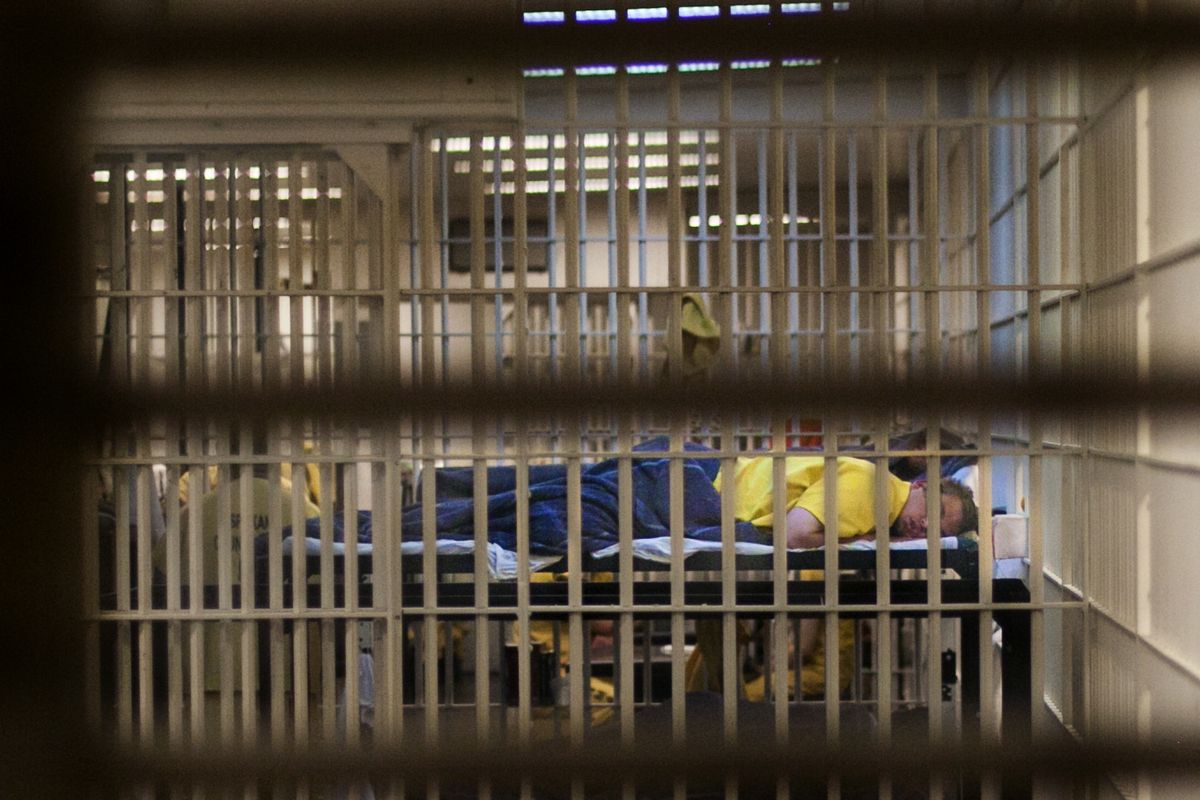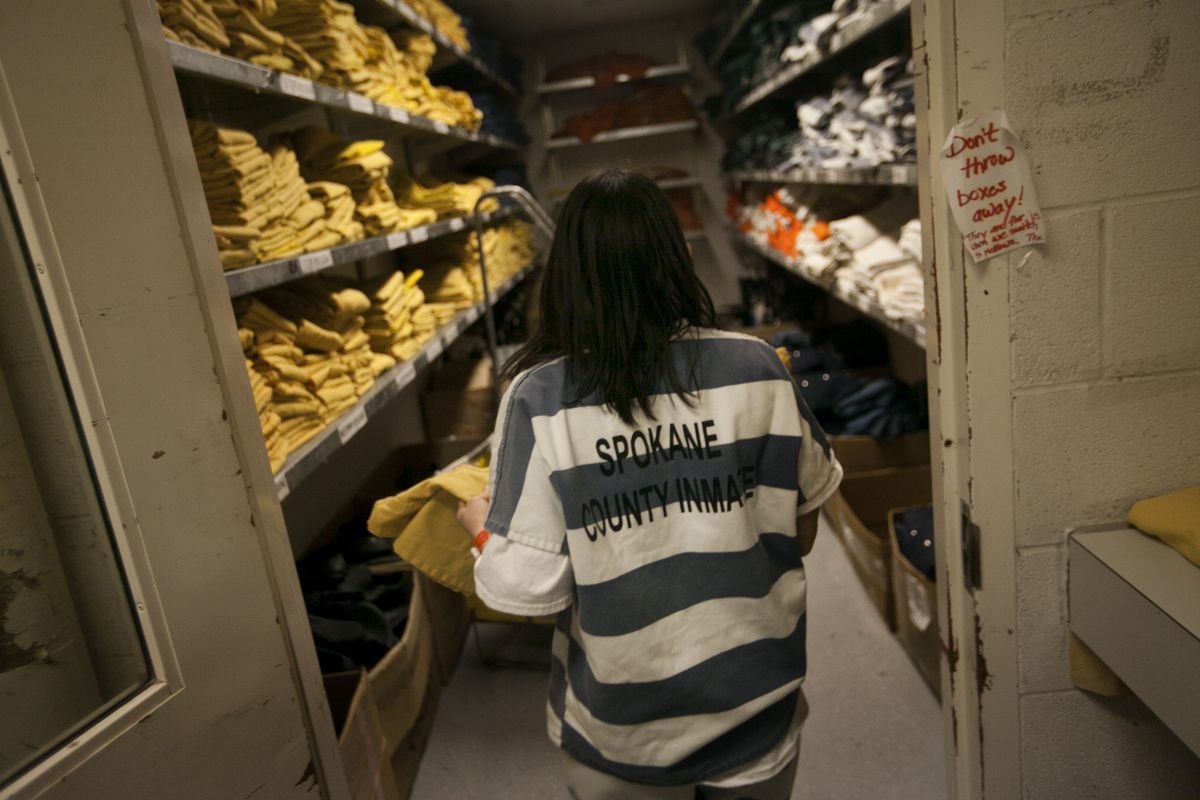Spokane County Jail is overcrowded and falling apart
An inmate sleeps in a crowded cell in 2014 in the Spokane County Jail. As the county seeks ways to upgrade and ease overcrowding, Sheriff Ozzie Knezovich says 70 percent of the jail population is at high risk to reoffend. “We are incarcerating the worst of the worst,” he said. (Tyler Tjomsland)Buy a print of this photo
Spokane County’s 28-year-old jail is showing its age.
Water collects on the floor in the basement kitchen because drains don’t work. Doors to the walk-in coolers are jammed. The subfloor is failing. Elevators are touch-and-go.
A new kitchen could cost $9.6 million – money that county commissioners don’t have.
But the real problem runs much deeper than renovations. This jail was not built to handle the number of prisoners it houses today, nor the number of hard-core and repeat offenders who populate the lockup.
This is where the revolving door of justice does the most spinning.
For years, Sheriff Ozzie Knezovich has been saying that too many repeat felons are being arrested and released back into the community because there isn’t enough jail space.
As a result, property crime rates have skyrocketed, he said.
“You’ve raised an entire generation of criminals who know there are no consequences to crime because you are going to get back out,” Knezovich said.
From 2008 through 2012, Spokane County saw a 55 percent increase in property crime. There were 27,301 property crimes reported in the county in 2012. In the city of Spokane, the property crime rate was three times the national average that year.
At some point, the community is going to have to come up with more jail beds, officials say.
But voters may not like the idea of raising taxes to fund an expensive new jail. A jail ballot measure has been considered a long shot, one of the reasons county commissioners have postponed putting the question to voters for at least the past seven years.
In addition, county commissioners said they are awaiting results from a new round of criminal justice reform so they can plan a jail that accurately meets future needs.
Mary Lou Johnson of the Smart Justice campaign is endorsing reforms as a way to avoid the need for new beds. Well-tested techniques for getting offenders out of jail sooner need to be fully implemented in Spokane, she said.
“If we build beds, they will fill them,” she said. “I think there are still ways to reduce that population.”
Still, a cornerstone of reform is construction of a community corrections center to house rehabilitation, day reporting, re-entry classes and work programs.
“Our goal is to reduce recidivism,” County Commissioner Todd Mielke said.
The community has long supported adding police and sheriff’s deputies to make arrests, but the county also needs bunk space and effective rehabilitation programs if it wants to reduce crime rates, Mielke said.
‘Worst of the worst’
Of the 900-plus prisoners held last month at the jail and Geiger Corrections Center, some 750 were held for felonies or wanted by the courts or other jurisdictions.
“People think we are a misdemeanor facility. We are not,” jail Lt. Mike Sparber said. “The type of people we hold are felons.”
Knezovich estimated that 70 percent of the jail population in Spokane is at high risk to reoffend. “We are incarcerating the worst of the worst,” he said.
County statistics show that about 80 percent of the jail inmates are felons, up from 71 percent in 2008.
The $35 million annual cost of running the jail is a quarter of the county’s general fund budget and about $3 million more than the cost of operating the Sheriff’s Office and Spokane Valley police.
The 11-story jail opened in 1986 with 463 single-bunk cells arranged in a dormitory-like setting. It was considered a vast improvement at the time. The old jail in the Public Safety Building had large holding cells, which were dominated by con bosses.
As jail populations started rising, the county added a second bunk to many of the cells.
By the mid-’90s, the jail was considered overcrowded, Knezovich said.
Geiger Corrections Center, a former military dormitory, became the relief valve for the jail in the late 1990s and is still being used.
Twelve years ago, former Sheriff Mark Sterk said, “I think we all recognize that we’re going to have to expand our jail capacity in the not-too-distant future, and that means we need to start planning now. The board (of county commissioners) has done a good job of expanding minimum-security beds in the recent past. The problem now is maximum-security beds.”
Inmate numbers rising
County inmate counts rose to the 1,200 range from 2007 through 2009. That’s when a series of alternative programs were implemented to reduce the jail crowding, including specialized treatment courts for people with mental health or drug problems. This helped drop the inmate population to around 700 in 2010.
The numbers are creeping back up, only this time with more hard-core offenders. Now the county has so many maximum-security inmates that it can no longer use double-bunk cells on some floors.
There is a growing problem of inmate violence. The jail has so many street gang members that jailers have to be careful not to let rival gang members out of their cells at the same time or a fight will erupt. Jailers are frequently injured trying to break up the fights, Sparber said. The jail reported 152 incidents last year, a 58 percent increase over 2011.
But, according to state law, inmates have to be let out of their cells three times a week so they can shower, exercise, make phone calls, meet visitors or work with their attorneys.
The answer has been rolling lockdowns that keep inmates confined to their cells for most of the day.
“A jail is a small city,” Sparber said. “You can’t manage it when it’s overstrained.”
One option being considered by county commissioners is to build additional jail housing to the north of the existing jail along with an expanded booking area and weekend courtroom.
The jail gets about 28,000 bookings a year, more than double the 11,000 bookings it was designed to handle.
When bookings back up, the jail goes on “red-light status,” which means it will not accept newly arrested offenders.
Elsewhere in the facility, elevators break down frequently. A mechanical storage facility for inmate personal property has ongoing repair issues.
Phased approach
Even if county commissioners come up with a plan to add more cells and fix the kitchen and booking area at the jail, it will still need to consider replacing Geiger, which was built for military housing, not inmates, Mielke said.
A proposal for a new jail in 2008 had a $245 million price tag. That was later trimmed to $199 million.
Now jail officials say they could take a phased approach to adding facilities, with the first step being construction of additional beds next to the existing jail, a community corrections center, a new kitchen and larger booking area.
Criminal justice reforms outlined in a 60-page report in December by a blue-ribbon panel hold promise for reducing the jail population through diversions and treatment programs.
It is estimated that between 60 and 80 percent of the jail population has drug or mental health problems or a combination of both.
The jail became accredited as a mental health facility in 2009 and is now devoting one cellblock to mental health treatment.
Despite the efforts, those on the jail front lines are certain that the number of hardened criminals is more likely to go up than down. The jail is the holding place for many of them prior to trial. That leaves the question of what happens when the jail is full.
“We can’t stack them like cord wood,” jail Director John McGrath said.

